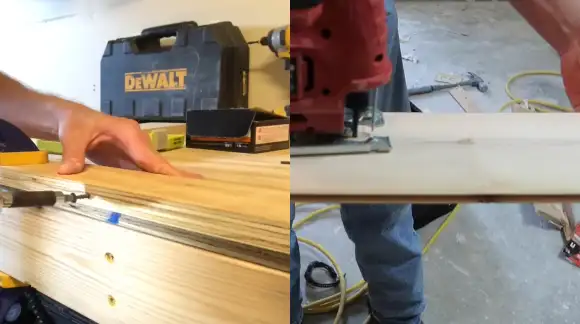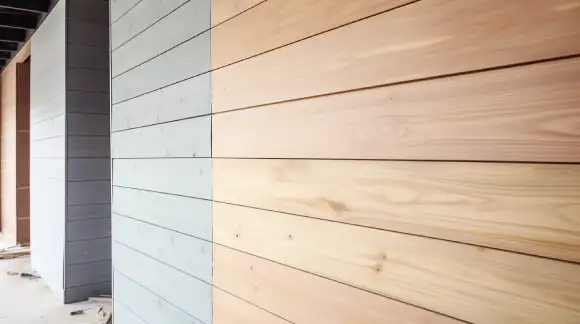Last Updated on September 16, 2023
A good wall material can make all the difference in achieving the perfect look and feel for home design. MDF and Wood Shiplap are two popular options that offer contrasting benefits. Although both options can be used as wall siding or ceilings, they differ.
In terms of composition and material, MDF comprises wood fibers and resin, while wood shiplap is made from solid wood boards. Also, when considering durability and strength, MDF is prone to water damage and can easily chip or break, whereas wood shiplap is more durable and resistant to wear and tear.
Today, we will discuss the key differences between MDF and Wood Shiplap, considering various aspects such as composition, material, durability, strength, etc. So continue reading to find out the perfect wall siding for your home.
8 Differences Between MDF and Wood Shiplap for Your Home Siding

When considering MDF or wood shiplap use for your home siding, you should understand the key differences between these materials:
- Composition and material
- Durability and strength
- Panel weight
- Moisture resistance
- Appearance and aesthetic preference
- Ease of installation
- Maintenance and longevity
- Cost Comparison
1. Composition and Material
MDF (Medium Density Fiberboard) is made from finely shredded recycled wood fibers, wax, and resin. Its tightly compressed composition results in a uniform density, providing a smooth and grainless surface ideal for achieving a sleek modern finish.
Meanwhile, wood shiplap embraces the authenticity of natural wood. It consists of horizontally aligned wooden boards with overlapping edges, creating charming grooves between each plank. This choice celebrates the distinctive grain patterns and knots of various wood species.
2. Durability and Strength
When comparing MDF and wood shiplap, durability and strength are important factors. MDF is known for maintaining its shape, making it a great choice for projects under these conditions, like bathroom cabinets and shelving units.
However, Shiplap is built to withstand more demanding applications, so it’s great for projects that need a lot of weight or will experience structural stress. The fire resistance of modern shiplap differentiates it from its competitors. Also, shiplap can span longer distances, providing a more even weight distribution and reducing the likelihood of warping or bowing.
3. Panel Weight
MDS is a dense, sturdy composite material heavier than wood shiplap. Its density means it’s less likely to warp or split, which can be a major plus when considering durability. However, you may find MDF difficult to handle if you work on a DIY project without heavy machinery.
On the other hand, wood shiplap is a relatively lightweight option that you might find much easier to work with. It’s also quite versatile, with different wood species and finishes available to suit your aesthetic needs.
4. Moisture Resistance
When comparing MDF and wood shiplap for moisture resistance, remember that MDF is prone to absorbing moisture if not adequately sealed. This makes it better suited for indoor applications and areas with controlled humidity.
Alternatively, wood shiplap offers varying moisture resistance depending on the species chosen. For example, cedar exhibits natural resistance to moisture, making it a more suitable choice for outdoor applications where exposure to water is inevitable.
5. Appearance and Aesthetic Preference
Consider the aesthetic differences between smooth and uniform finishes versus rustic charm and natural variations when considering your preferred appearance.
The smooth and uniform finish of MDF makes it ideal for modern designs. It offers a pristine canvas for paint and ensures a polished look by minimizing imperfections. The consistent texture of MDF complements minimalist aesthetics, creating a clean and contemporary finish.
As opposed to this, wood shiplap celebrates the individuality of each board’s grain pattern and texture. Its rustic charm comes from the natural variations in wood, which contribute warmth and character to any space.
6. Ease of Installation
MDF shiplap has the advantage of requiring less prep before painting than wood shiplap. Factory-primed MDF is ready to paint right out of the box. This can save you a lot of time and effort during the installation process.
In contrast, installing wood shiplap may be more difficult due to natural variations in wood dimensions. It can expand and contract due to changes in temperature and humidity. Proper alignment and spacing are crucial to achieve a seamless appearance.
7. Maintenance and Longevity
Although MDF resists warping, cracking, and bowing better than wood, it still requires proper care and maintenance to extend its lifespan. For instance, you must protect it from the elements that can damage it, such as rain or extreme sunlight exposure.
In contrast, the main disadvantage of wood shiplap is its proneness to warping and bowing over time, especially in changing humidity conditions. With appropriate maintenance and sealing, wood shiplap can last for decades, making it a cost-effective option in the long run.
8. Cost Comparison
MDF is made from wood fibers and glued resin, which allows for a more streamlined and cost-effective manufacturing process. On the other hand, wood shiplap has a more natural and rustic feel but also comes with a higher price tag.
Can I use MDF as Shiplap for home siding?

You can use MDF as a shiplap for your home siding, creating a sleek and modern exterior. It compresses wood fibers with adhesive under high pressure and heat. The result is a strong board that resists warping and swelling, making it suitable for indoor applications.
What is the disadvantage of using MDF as Shiplap?
There are several disadvantages if you decide to use MDF as a shiplap siding for your home. But the primary disadvantage is MDF doesn’t hold screws very well due to its dense composition. This can lead to issues with stability and durability over time.
Can MDF be used for exterior siding?
MDF is unsuitable for exterior siding because it is more susceptible to moisture damage and absorption. Exterior siding must withstand weather conditions, including rain, snow, and humidity. When exposed to moisture, MDF can swell and warp because it is made from wood fibers glued together using resins.
What kind of wood is used for shiplap?
In terms of interior shiplap, most are made from pine or poplar, both durable and affordable. But when considering exterior shiplap, cedar and redwood are popular choices due to their natural resistance to decay and insects. Pine is also commonly used for its affordability and availability.
MDF vs Wood Shiplap: Carefully Choose One for Your Wall Paneling
Choosing between MDF and Wood Shiplap for your wall paneling can be tough.
While MDF offers a uniform and smooth finish, it may not be as durable or moisture-resistant as Wood Shiplap. Conversely, Wood Shiplap may require more effort to install, but it provides a timeless and charming look that can add warmth and character to any space.
Ultimately, your choice will depend on your personal design preferences, budget, and intended usage. But whatever you decide, properly maintain your wall panels to ensure their longevity.
![MDF vs Wood Shiplap: 8 Differences [Exposed]](https://handyworkshop.com/wp-content/uploads/2023/09/MDF-vs-Wood-Shiplap.webp)


